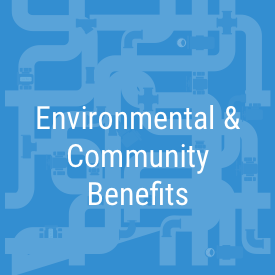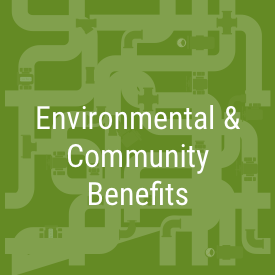Preferred project: A federal-state-local partnership
This federally authorized project continues a project in partnership with the U.S. Army Corps of Engineers (USACE) to plan, design and construct improvements along 5.5 miles of the channel extending from Interstate 280 to Blossom Hill Road. Improvements include channel widening, construction of floodwalls and levees, replacement of road crossings and planting of streamside vegetation. Reducing flood frequency and bank erosion will improve water quality, while planned mitigation measures will give fish access to an additional 12 miles of habitat within and upstream of the project reach.
USACE has initiated a General Re-evaluation Report (GRR) of the preferred project, which is anticipated to be completed by October 2023. The scope of the project may change as a result of the GRR findings.
Local-funding-only project
The locally funded project entails constructing flood protection improvements along 4,100 feet of Guadalupe River between the Southern Pacific Railroad (SPRR) crossing, downstream of Willow Street, to the Union Pacific Railroad (UPRR) crossing, downstream of Padres Drive (Reach 7). It also includes completing a gravel augmentation project along approximately 800 linear feet of the Upper Guadalupe River in San José, from approximately the Union Pacific Railroad Bridge to West Virginia Street Bridge to improve aquatic habitat for migrating steelhead and channel stability. Flood damage will be reduced through the local-funding-only project. However, protection from the 1% (100-year event) flood is not provided without completion of the entire Upper Guadalupe River Flood Protection Project.
Mitigation elements of the project, namely Reach 10B (from Curtner Avenue to Almaden Expressway) and Reach 12 (from Branham Lane to Blossom Hill Road), were completed in 2015 in partnerships with USACE. Construction on the gravel augmentation project is scheduled to begin in August 2021.








On August 13, 2024, the Valley Water Board held a formal public hearing and approved modifying the funding allocation for Project E8: Upper Guadalupe Flood Protection Project, transferring $42,670,000 to Project E6: Upper Llagas Flood Protection Project. The reallocated funds are not expected to be needed by the Upper Guadalupe Flood Protection Project to complete Valley Water’s cost-share for the preferred project (KPI #1) and will not affect the project schedule. The reallocated funds will serve to complete the shovel-ready final phase of the Upper Llagas Flood Protection Project.
On April 9, 2024, the Valley Water Board held a formal public hearing and approved modifying KPI #2, which includes aquatic habitat improvements to benefit all native fish species. Originally, the local funding-only KPI (KPI 2) only mentioned improving aquatic habitat for migrating steelhead.
Valley Water and USACE Public Meetings
On Dec. 8, 2022, Valley Water and USACE held a public meeting to present the recommended plan of flood protection work along the Guadalupe River.
- Meeting Recording ( passcode: %1?xgi6= )
- Presentation
On Aug. 6, 2022, Valley Water and the USACE held a public meeting to collect feedback on future work on the Upper Guadalupe River. A hybrid model was utilized for the meeting, held in-person at the Alma Community Center and online through Facebook Live.
The project reaches
The approximately 5.5-mile-long project in San José is separated into seven sections known as reaches, numbered 6 through 12. Improvements include channel widening, floodwall and levee construction, replacement of road crossings, gravel augmentation, and streamside vegetation planting.
Reach 6 Complete
In 2021, Valley Water installed the two gravel augmentation sites for the Reach 6 Aquatic Habitat Improvement Project, which is part of the local-funding-only project under KPI #2. Valley Water will monitor the stability of the two gravel augmentation sites until 2026.
USACE General Re-evaluation Report (GRR)
Since FY15 (July 2014 – June 2015), a lack of federal funding has stalled the design and construction of the flood protection elements of Reaches 7-12 (excluding Reach 10B and Reach 12). In January 2021, the USACE began a General Re-evaluation Study, a study to re-evaluate the scope of the project and the associated benefits and construction cost that can help make the project more competitive for federal funding. The General Re-evaluation Report (GRR) is expected to be completed by June 2025. A new preferred project (KPI #1) and project schedule will be developed following the completion of the study in FY25 (July 2024 - June 2025). As per the USACE schedule, the design process is projected to begin in 2026 and take two years, and construction is expected to begin in 2028 and be completed by 2033.
The local-funding-only KPI #2 includes Reach 7, stretching from the UPRR bridge crossing downstream of Willow Street to the abandoned UPRR bridge upstream of Alma Avenue. If Valley Water were to assume the responsibility of continuing the design of the local-funding only project in FY24, project construction could be completed by FY29 (July 2028-June 2029).
For more information, please visit USACE's Upper Guadalupe River webpage at https://www.spn.usace.army.mil/Missions/Projects-and-Programs/Current-Projects/Upper-Guadalupe-River/
Right of Way
In 2019, Valley Water acquired all the necessary rights of way for Reach 7. The project has not received federal funding since FY15. The acquisition of rights-of-way and/or the design and construction of Reaches 7 through 11 remains on hold until the project secures federal funding.
Reaches 7 and 8
In 2019, the project did not receive federal funding to complete the design of Reaches 7 and 8. The USACE is updating the total project cost while continuing to seek federal funding to complete the reach’s design and construction.
Willow Glen Way Bridge Complete (Reach 9)
In 2007, Valley Water, in collaboration with the City of San José, replaced the Willow Glen Way Bridge along Reach 9 with a longer-span bridge. The new bridge, east of Bird Avenue, was built to accommodate future channel widening to convey greater flows and provide flood protection while improving traffic and pedestrian safety.
Reaches 10B and 12 Complete
In 2012, Valley Water and USACE completed Reach 10B, which runs between Wren Drive and McBride Loop. The project restored the waterway to a more natural environment by providing a meandering channel, pools, and in-stream features such as stream logs to allow gravel and sediment deposition and improve stream habitat.
In 2016, Valley Water and USACE completed work on Reach 12 which includes more than a mile stretch of the river channel critical to the larger project. Set between Branham Lane and Blossom Hill Road, the area had available land to improve habitat along the river to offset the loss of habitat areas further downstream, where river widening for the overall flood protection project had to occur. The project improved habitat for native fish like steelhead trout and Chinook salmon by planting native vegetation and trees along the river and stabilizing the low-flow channel. With the addition of access roads and ramps, maintenance crews now have easier access to the river channel.
In 2019, the USACE submitted a draft operations and maintenance manual for Reaches 10B and 12 to Valley Water for review. The USACE finalized the manual in September 2019 and transferred operations and maintenance responsibilities for Reaches 10B and 12 to Valley Water.
August 2024
FY22-36 Key Performance Indicator for the Safe, Clean Water Program
-
Preferred project with federal and local funding: Construct a flood protection project to provide 1% (100-year) flood protection to 6,280 homes, 320 businesses and 10 schools and institutions.
-
With local funding only: Construct flood protection improvements along 4,100 feet of Guadalupe River between the Southern Pacific Railroad (SPRR) crossing, downstream of Willow Street, to the Union Pacific Railroad (UPRR) crossing, downstream of Padres Drive, and provide gravel augmentation along approximately 800 linear feet of the Upper Guadalupe River in San José, from approximately the Union Pacific Railroad Bridge to West Virginia Street Bridge to improve aquatic habitat for migrating steelhead and all native fish species and channel stability.
Benefits
-
Preferred project will construct 1% flood conveyance capacity for 5.5 miles of channel in San José, protecting approximately 6,280 homes, 320 businesses and 10 schools/institutions
-
Local funding only constructs improvements to 4,100 linear feet of Guadalupe River between the Southern Pacific Railroad (SPRR) crossing, downstream of Willow Street, to the Union Pacific Railroad (UPRR) crossing downstream of Padres Drive to convey 1% flow
-
Improves stream habitat values and fisheries
-
Improves stream water quality
-
Allows for creekside trail access
-
Addresses climate change
Geographic Area of Benefit
San José
Flooding History
Damaging flood events occurred in 1982, 1983, 1986, 1995, and 1998. Severe flooding in 1995 damaged more than 150 homes in the Gardner, Willow Glen, and South San José residential districts and shut down Highway 87 and the parallel light rail line – both major commuter thoroughfares. Freeway and light rail flooding occurred again in 1998.
Project Background
The Upper Guadalupe River Flood Protection Project was initially part of the voter-approved Clean, Safe Creeks and Natural Flood Protection Plan (CSC Plan) that came into effect in Fiscal Year 2001-2002 (FY02). In 1999, the U.S. Army Corps of Engineers (USACE) authorized the construction of the project to provide 1% flood protection along the Guadalupe River from Highway 280 to Blossom Hill Road.
In October 2007, Valley Water, in collaboration with the City of San José, replaced the Willow Glen Way Bridge of Reach 9. In August 2012, Valley Water completed the construction of flood protection improvements and vegetation planting on Reach 6 (from Highway 280 to the Union Pacific Railroad crossing).
In November 2012, the USACE completed the construction of flood protection improvements and some vegetation planting of Reach 10B (from Wren Drive to Koch Lane). However, the USACE could not complete the remaining vegetation planting due to a lack of federal funding.
In response to the funding issue, in March 2012, the Board directed staff to implement a modified strategy for the project. This revised strategy included Valley Water completing the design and construction of Reach 7 (from downstream of Willow Street to upstream of Alma Avenue) and Reach 12 (from Branham Lane to Blossom Hill Road) to meet the intent of the Local Project commitment in the Program. Valley Water continued acquiring rights of way necessary and relocating utilities for the construction of flood protection improvements along the project.
Voters Approve 2012 Safe, Clean Water Program
In November 2012, voters approved the Safe, Clean Water and Natural Flood Protection Program (2012 Program), which replaced the CSC Plan and became effective on July 1, 2013. The project was carried forward into the 2012 Program.
In November 2015, USACE and Valley Water completed the construction of Reach 12 (from Branham Lane to Blossom Hill Road), a mitigation element of the project, and Valley Water contributed local funding to complete the reach. USACE completed 65% design documentation for Reaches 7 and 8.
However, due to the lack of federal funding since FY15, the design and construction of the preferred project (KPI #1), comprising Reaches 7, 8, 10A, 10C, and 11, was halted. At the same time, the USACE focused on updating the total project costs to determine the path for future federal funding. As a local sponsor, Valley Water is responsible for acquiring all the right-of-way and relocation of utilities. In FY19, Valley Water suspended the right-of-way acquisition.
Under the 2012 Program, the local-funded-only project (KPI #2) required Valley Water to construct Reach 7 from the UPRR bridge crossing downstream of Willow Street to the abandoned UPRR bridge upstream of Alma Avenue. However, due to the lack of federal funding, Valley Water decided also to finish Reach 6 and assume the responsibility of maintaining and monitoring the Reach 10B (from Curtner Avenue to Capitol Expressway) and Reach 12 (from Branham Lane to Blossom Hill Road). This approach aimed to advance the overall project and ensure the establishment of mitigation plants.
In FY20, the USACE received funding for a General Re-evaluation Study due to increased construction cost estimates. The study began in January 2021 and is expected to be completed by the end of 2024.
Voters Approve Renewed Safe, Clean Water Program
In November 2020, voters approved the renewed Safe, Clean Water and Natural Flood Protection Program (Safe, Clean Water Program), replacing the 2012 Program. The project has continued in the renewed Safe, Clean Water Program.
About the Safe, Clean Water and Natural Flood Protection Program
In November 2020, voters in Santa Clara County overwhelmingly approved Measure S, a renewal of Valley Water’s Safe, Clean Water and Natural Flood Protection Program.
The program was first passed by voters in 2000 as the Clean, Safe Creeks and Natural Flood Protection Plan, then again in 2012 as the Safe, Clean Water and Natural Flood Protection Program. The renewal of the Safe, Clean Water Program will continue to provide approximately $47 million annually for local projects that deliver safe, clean water, natural flood protection, and environmental stewardship to all the communities we serve in Santa Clara County.
While evaluating ways to improve the 2012 program, Valley Water gathered feedback from more than 21,000 community members. That helped Valley Water create the six priorities for the renewed Safe, Clean Water Program, which are:
Priority A: Ensure a Safe, Reliable Water Supply
Priority B: Reduce Toxins, Hazards and Contaminants in our Waterways
Priority C: Protect our Water Supply and Dams from Earthquakes and Other Natural Disasters
Priority D: Restore Wildlife Habitat and Provide Open Space
Priority E: Provide Flood Protection to Homes, Businesses, Schools, Streets and Highways
Priority F: Support Public Health and Public Safety for Our Community
Each year, Valley Water prepares a report providing a progress update for each of these program priorities, along with fiscal year accomplishments.
To ensure transparency and accountability to the voters, the ballot measure also created an Independent Monitoring Committee, appointed by the Santa Clara Valley Water District Board of Directors. The Independent Monitoring Committee annually reviews the program’s progress to ensure the outcomes are achieved in a cost-efficient manner and reports its findings to the Board. Additionally, the IMC also reviews each proposed 5-year implementation plan prior to its submittal for Board approval.
In addition, the program requires three independent audits.


